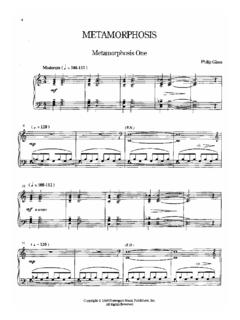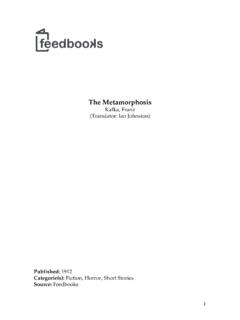Transcription of Ovid's Metamorphoses: Book One - Department of Classics
1 Ovid's metamorphoses : Book OneA new text reader by Sin R. GuanciAbout the TextThe Latin text used in this book comes from the Oxford Classical Text Series, but the author has made changes where necessary regarding punctuation, capitalization, and MSS differences. Also, this text uses the letter 'v' where the OCT text prefers 'u,' such as, for example, in line 11, this text reads nova, instead of noua. Punctuation was changed in the following lines: 5, 7, 10-13, 40-42, 78, 80, 99, 115, 169, 192, 212, 259, 328, 330, 344-345, 352, 392, 400, 404, 411, 418-420, 436, 440, 508, 540, 548, 575, 622, 630, 638, 653-654, 701, 703, & following changes were made regarding capitalization: line 521: Opiferque, 540: Amoris, 586: manes, & 622: manuscript differences, the following lines differ from the OCT text: Line 92: legebantur was used instead of ligabanturLines 544 and 545 of the OCT text were omitted and line 544a in the OCT text is labeled 544 in this 712.
2 Tenuisse was used instead of changes include the use of pluviaque instead of pluvioque in line 66, Peneus for Peneos in line 569, Sperchius for Sperchios in line 579, and instead of in line of 2 List of 8 Section I: The Beginnings of the II: The Four 25 Section III: The Giants and the 35 Section IV: 43 Section V: The 53 Section VI: Deucalion and 61 Section VII: Humans and Other Species are 72 Section VIII: Apollo, the Python, and 78 Section IX: 95 Section X: Argus and 102 Section XI: Mercury, the Syrinx, and 110 Section XII: Io and 117 Translation of Book This text has been written in part as a teaching project in fulfillment of an MA in Latin from the University of Georgia in Athens, Georgia.
3 Aside from my thesis committee, the intended audience for this text is advanced level secondary school students and intermediate level undergraduate students of Latin. The translation at the back is intended for use at the discretion of the instructor of aforementioned wrote the explanatory notes after much consultation of previously published commentaries, in particular those published by the following authors: William S. Anderson, Franz B mer, Nathan Covington Brooks, Hill, and Lee. I have tried to add to and improve upon their ideas, as well as to present those ideas in such a way as to be interesting to and easily understood by my target audience.
4 This text would not have been possible without the assistance, revisions, support and seemingly limitless patience of my fabulous committee members: Dr. Erika Hermanowicz, Dr. Christine Albright, and Dr. Nicholas Rynearson. In addition, the completion of my degree would not have been possible without everyone in the Classics Department at UGA. A HUGE thank you goes to Dr. James Anderson, Ludi Chow, Dr. Keith Dix, Kelly Dugan, Anna Duvall, Dr. Mario Erasmo, Marilyn Evans, Nat 'Culex' Fort, Rebecca Holcombe, Kyle Khellaf, Dr. Richard A. LaFleur, Kyle McGimsey, Nate Moore, Dr. John Nicholson, Dr. Naomi Norman, Lizzie Parker, Andy Paczkowski, JoAnn Pulliam, Charlie Russell-Schlesinger, Clayton Schroer, Dr.
5 Sarah Spence, Kay Stanton, Dr. Benjamin Wolkow, Tony Yates colleagues, professors, supervisors, coworkers, peers, and, most importantly, friends. I would be incredibly remiss if I did not give due thanks to the people outside of the Classics Department friends, family, loved ones those who have loved and supported me and been there for me in every way possible throughout the last two years (and much much longer): Mom, , Ed Goll (you can have our brain back now), Corey McEleney, Renee Bourgeois (rest her soul), Susan Yund (and everyone at the GCB), Kath Whelan, Stevie King, Greg 'Rain' Rebis, Angela Romito, Jake Jackson & Rhys May (my first GA friends), Karen Schlanger, Chucky Hanson (our friendship can now drink), Mark Frens, Mike 'Soda Pop' Cevoli, Lodore Brown, Pete 'Fuzzy' Bianconi, Pete 'the other white pete' Rodgers, and Brian 'Moe' Monahan.
6 Thank you all, from the bottom of my soul. Sin R. GuanciUniversity of GeorgiaAthens, GAIntroductionAbout the PoetPublius Ovidius Naso, commonly known as Ovid, was born on March 20, 43 BCE. His hometown was Sulmona, which is now called Abruzzo. Coming from a wealthy equestrian family, he attended the best schools in Rome. Setting out on the path leading to a career in law and politics, he traveled to Greece for the completion of his schooling. Upon returning to Rome, he held a few minor political offices and then abandoned his political aspirations altogether. It was not long before he was heavily involved in the most elite literary circles of Rome and was building relationships with the most famous poets.
7 He married his third wife when he was forty years old. By the year 8 CE, his career as a poet was at the height of its success. At that time, and rather abruptly, Ovid was relegated by the emperor Augustus from Rome to Tomi, a city on the Black Sea now known as Costanza. Relegation meant that, unlike straightforward exile, he could keep his citizenship and his possessions, but he could never return to the city of Rome. Ovid died in Tomi in either 17 or 18 Works of OvidOvid's work spanned several different genres. He published his first work, the Amores, a few years after 20 BCE. In its first publication, the Amores was five books; the edition that has survived was published around 1 CE and is three books, comprising forty-nine elegies, totaling nearly 2500 lines of verse.
8 The poems in the Amores all address the subject of love and are written in elegiac couplets. Unlike his elegiac predecessors Catullus, Gallus, Propertius, and Tibullus Ovid's first foray into the world of elegy is not centered around the love of one specific woman. Instead, the poet claims not only that he is not able to be satisfied with just one woman, but that any beautiful woman will do. Around the same time period, Ovid published the first set of letters (numbers one through fifteen) known as the Heroides. These are letters written in verse from famous female characters to their lovers. The characters come mostly from mythological stories, including Penelope, Ariadne, and Dido, but number fifteen is a letter from Sappho to Phaon.
9 The Heroides are also written in elegiac couplets. There is a second set of letters (numbers sixteen through twenty-one) which is also known under the title, Heroides, which were published much later, just before Ovid's exile (between 4 and 8 CE). These letters, instead of being one-sided, are correspondences between three pairs of lovers: Paris and Helen, Hero and Leander, and Acontius and Cydippe. The twenty-one letters that make up the Heroides total nearly 4000 lines of poetry. Between 12 and 8 BCE, Ovid enjoyed great success as a playwright. His Medea was quite popular, but, unfortunately, none of his tragedy Ars Amatoria is comprised of three books of verse written in elegiac couplets.
10 The first two books, addressed to men, according to Conte, were written between 1 BCE and 1 CE. The third book, addressed to women, along with the Remedia Amoris and the Medicamina Faciei Femineae ( The Cosmetics of Women ) were published shortly thereafter. While the Ars and the Remedia have survived intact, only a hundred lines of the Medicamina remains. These three works are all didactic, serving essentially as instructional manuals about love. From 2 CE until his exile in 8 CE, Ovid wrote two major works: the metamorphoses , and the Fasti. The Fasti is written in elegiac couplets, but was only half finished. There are six books, each covering one month from January to June.









